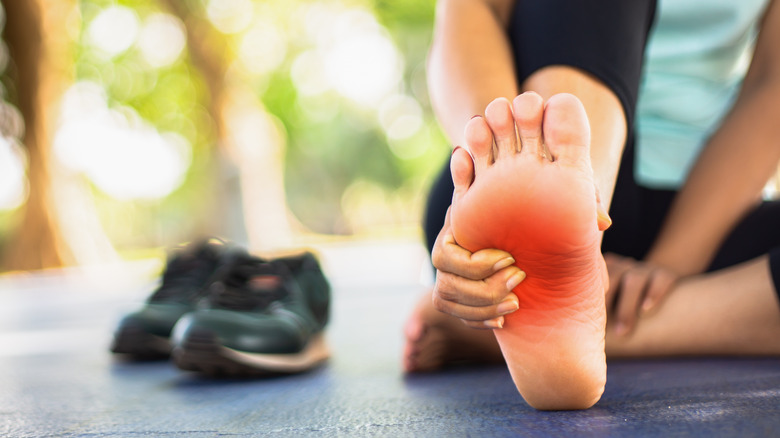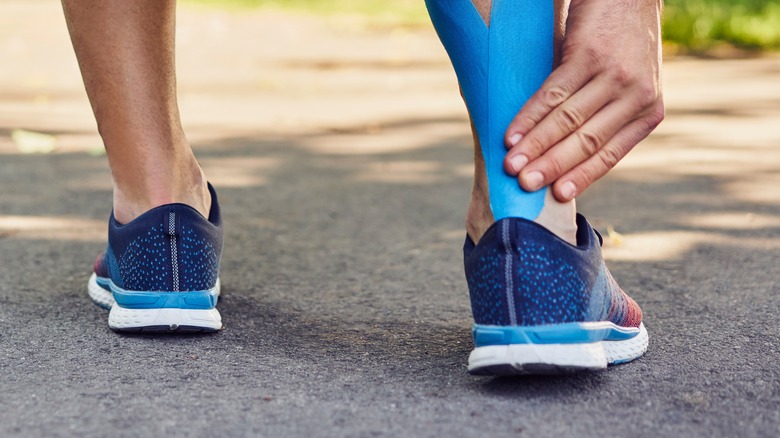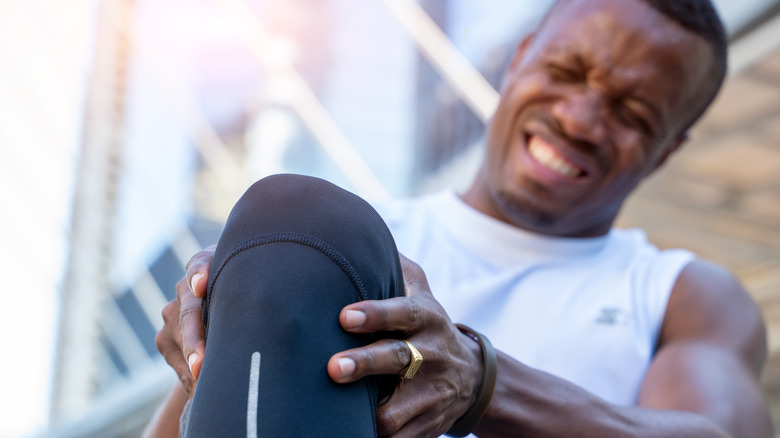The Most Common Running Injuries And How To Prevent Them
Running provides many health benefits such as building strong muscles and bones, improving heart health, and burning excess calories. According to Ask Wonder, more than 600 million people in the world were runners in 2017, and more people began running during the COVID-19 pandemic (via RunRepeat). However, about half of runners sustain an injury each year (per Yale Medicine).
Cleveland Clinic identified six common injuries that typically plague both new and seasoned runners at least once in their lifetime. Three of the most common injuries are associated with strained tendons, such as Iliotibial band — ITB — syndrome, Achilles tendonitis, and plantar fasciitis. Two bone-related running injuries are stress fractures and shin splints. Although runner's knee can develop from strained tendons, this injury is mostly confined to the cartilage in the knee (via Healthline). According to Yale Medicine, many injuries occur when we train too hard or run with improper form.
Running injuries of the tendons
ITB syndrome is a strain of the iliotibial band that runs along the outer leg from the hip to the knee. Some of the causes of ITB syndrome are increasing mileage too quickly, incorrect shoes, or poor form. You might feel pain in your hip or the outer part of your knee (via Cedars Sinai).
Achilles tendonitis will feel like a sharp pain in your Achilles tendon, which is located just above your heel. This tendon gets inflamed when your calf muscles are tight. A strain in the Achilles tendon can also occur if you're suddenly running more hills or if you wear worn-out shoes (via Cleveland Clinic).
Plantar fasciitis occurs with too much stress on the tendon under your foot. You could feel it at your arch or at the tendon's insertion at the heel (per the American Academy of Orthopaedic Surgeons). Pain might occur when you first get out of bed in the morning or at the beginning of a run. Increasing running mileage too quickly or training on hard surfaces can bring on plantar fasciitis.
Running injuries to the bones and cartilage
Shin splints are stress fractures in the shin bone that will hurt while running. They can occur when you quickly increase the number of miles you log each week or suddenly shift your running from trails to hard roads. Shin splints can also occur if you have tight calves or weak hips that can't absorb the shock of running (per Cleveland Clinic).
Although shin splints are the most common type of stress fracture, you can also sustain a stress fracture in your hip or foot. These injuries are much more serious and sometimes involve wearing a boot or walking with crutches to reduce the amount of weight on the fracture. Some might require surgery (via Cleveland Clinic).
Any clicking, grinding, or rubbing while bending your knee might be a symptom of Patellofemoral Pain Syndrome, or runner's knee. You also might feel pain around your kneecap while running. Runner's knee can be caused by weak muscles in your calves or legs or tight Achilles tendons. Poor running mechanics or an excessive running program can also cause runner's knee (per Johns Hopkins Medicine).
Preventing the most common running injuries
Most running injuries can be prevented by heading to a specialty running store and getting properly fitted. Good running stores will often have treadmills and look at your stride while running (via Verywell Fit). It's time to get new running shoes between 300-500 miles, but that depends on whether you're a seasoned long-distance runner or a casual 5K runner.
According to Boston Children's Hospital, your running form can reduce your risk of injury. It's best to take shorter strides so that your foot doesn't reach too far past your knee. You'll also want to increase your cadence to 170 to 180 steps per minute and be careful not to strike the ground with your heel first. To prevent ITB syndrome and runner's knee, be sure your hips don't swing too far laterally. Ideally, they should remain relatively level.
Many eager new runners might want to sign up for a running race and begin a training plan. Running too much can be the cause of most running injuries, particularly if you increase your mileage too quickly. Although runners aren't typically known for their muscles, they can benefit from strength training the entire body involving several muscle groups at a time (via Runner's World). Runners can also prevent injuries by doing dynamic stretches before running and deeper, slower stretches after running. Runners could benefit from yoga for its emphasis on strength and flexibility.




